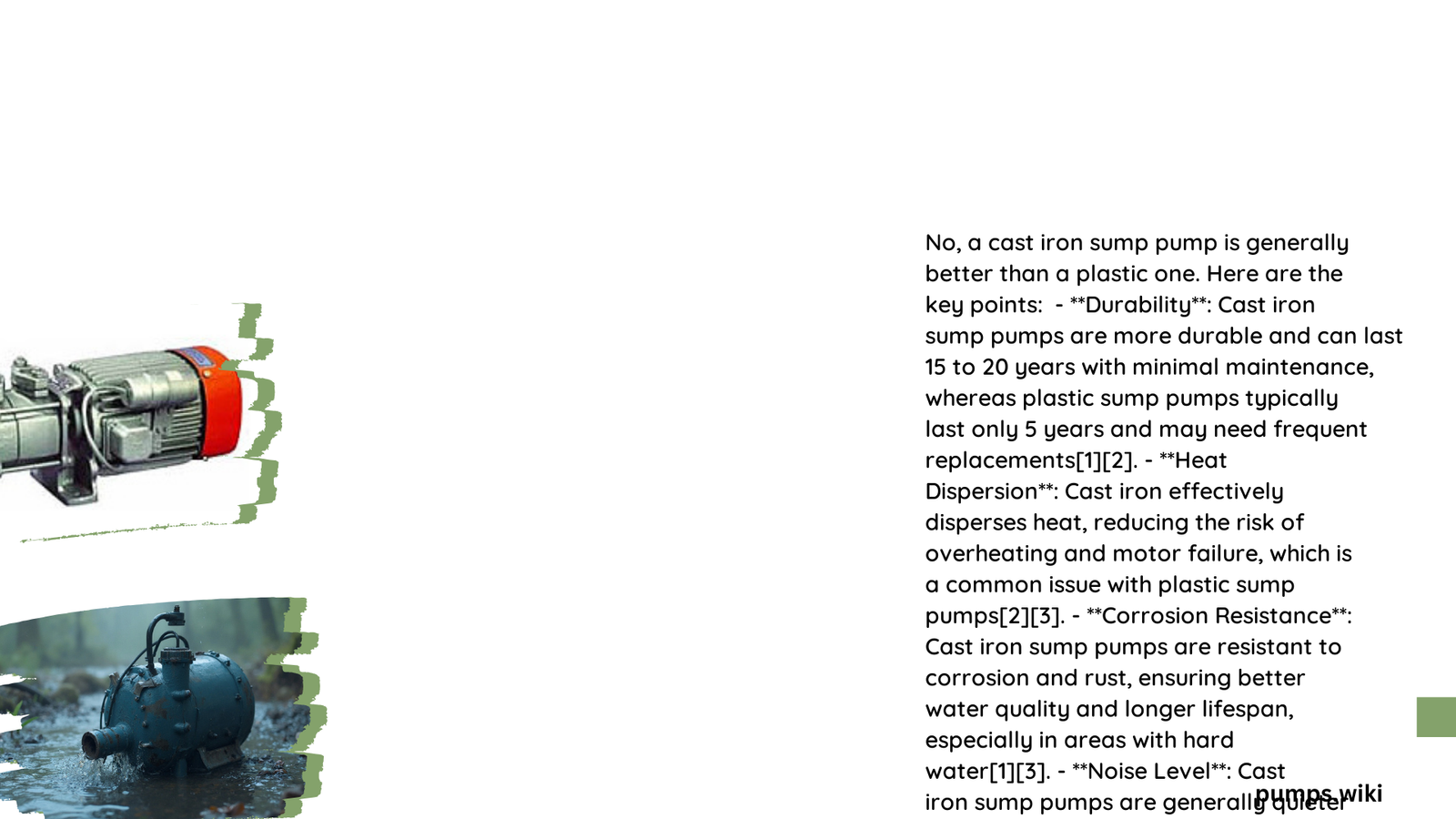When choosing a sump pump for your home, the debate between plastic and cast iron models is crucial. This comparison examines durability, cost, performance, and weight differences between plastic and cast iron sump pumps. While plastic pumps are lighter and less expensive initially, cast iron pumps offer superior durability and longevity. The choice depends on factors like budget, expected usage, and long-term maintenance considerations.
What Are the Key Differences in Durability Between Plastic and Cast Iron Sump Pumps?
The durability of a sump pump is a critical factor in its overall value and effectiveness. Let’s examine how plastic and cast iron sump pumps compare in terms of longevity, corrosion resistance, and failure rates.
Lifespan Comparison
- Cast Iron Sump Pumps:
- Typical lifespan: 10 to 20 years or more
- Known for exceptional longevity
-
Durability depends on usage and maintenance
-
Plastic Sump Pumps:
- Average lifespan: 5 to 15 years
- More susceptible to wear and tear
- Lifespan can be shorter under heavy use
Corrosion Resistance
- Cast Iron Sump Pumps:
- Better resistance to corrosion compared to plastic
- May still corrode over time if not properly maintained
-
More durable against debris and heavy use
-
Plastic Sump Pumps:
- Naturally resistant to corrosion and rust
- Can yellow and crack over time
- Plastic impellers more vulnerable to debris damage
Failure Rate Analysis
| Aspect | Cast Iron Sump Pumps | Plastic Sump Pumps |
|---|---|---|
| Heat Dissipation | Excellent, reducing motor failure risk | Poor, leading to potential overheating |
| Debris Resistance | High resistance to damage | More prone to damage from rocks and debris |
| Overall Failure Rate | Lower due to durability | Higher due to material limitations |
How Do Costs Differ Between Plastic and Cast Iron Sump Pumps?

When considering the financial aspect of choosing between plastic and cast iron sump pumps, it’s essential to look beyond the initial purchase price and consider long-term costs.
Initial Purchase Price
- Cast Iron Sump Pumps: Generally more expensive upfront
- Plastic Sump Pumps: More budget-friendly initial purchase
Installation Costs
Installation costs can be similar for both types, but consider:
– Potential need for additional support for heavier cast iron pumps
– Frequency of replacements affecting long-term installation expenses
Long-term Maintenance Expenses
- Cast Iron Sump Pumps:
- Lower maintenance requirements
- Fewer replacements needed
-
Potential for long-term cost savings
-
Plastic Sump Pumps:
- More frequent maintenance may be necessary
- Higher likelihood of replacements
- Initial savings may be offset by long-term costs
Hidden Costs and Potential Savings
- Cast iron pumps’ durability can lead to significant long-term savings
- Plastic pumps may incur higher costs over time due to replacements and potential damage
What Performance Metrics Should Be Considered When Choosing Between Plastic and Cast Iron Sump Pumps?
Performance is a crucial factor in selecting the right sump pump for your needs. Let’s compare plastic and cast iron sump pumps across various performance metrics.
Flow Rates (GPM)
- Cast Iron Sump Pumps:
- Often have higher water capacity
- Efficient in handling large volumes of water
-
Ideal for areas with frequent heavy rainfall or high groundwater levels
-
Plastic Sump Pumps:
- May have slightly smaller water capacities
- Effective for moderate amounts of water
- Suitable for areas with less severe water issues
Horsepower Ratings
Both cast iron and plastic sump pumps are available in various horsepower ratings:
– 1/3 HP
– 1/2 HP
– 3/4 HP
– 1 HP
The choice depends on the specific needs of your home and the expected water volume.
Energy Efficiency
- No significant difference in energy efficiency based solely on material
- High-quality pumps with efficient motors can provide better energy efficiency regardless of being plastic or cast iron
Operational Noise Levels
- Cast Iron Sump Pumps:
- Generally quieter operation
-
Denser material absorbs sound vibrations
-
Plastic Sump Pumps:
- May produce more noise
- Lighter construction can lead to increased vibration
How Does the Weight of Plastic and Cast Iron Sump Pumps Affect Installation and Use?
The weight difference between plastic and cast iron sump pumps can significantly impact installation, mobility, and overall performance.
Average Weights
- Cast Iron Sump Pumps:
- Weight range: 20 to 50 pounds or more
-
Significantly heavier due to cast iron density
-
Plastic Sump Pumps:
- Weight range: 10 to 20 pounds
- Much lighter and easier to handle
Implications for Installation and Mobility
- Cast Iron Sump Pumps:
- May require additional structural support during installation
- Heavier weight contributes to stability and durability
-
Less prone to movement during operation
-
Plastic Sump Pumps:
- Easier to install and move due to lighter weight
- May be more prone to vibration and noise
- Might require additional stabilization measures
In conclusion, while plastic sump pumps offer advantages in terms of initial cost and ease of installation, cast iron sump pumps generally provide superior durability, longevity, and performance. The choice between plastic and cast iron ultimately depends on your specific needs, budget, and long-term considerations for your home’s water management system.
References:
1. https://capstonewaterproofing.com/cast-iron-vs-plastic-sump-pumps/
2. https://www.basementsystems.ca/sump-pump/plastic.html
3. https://son-riseplumbing.ca/blog/everything-you-need-to-know-about-sump-pumps/
